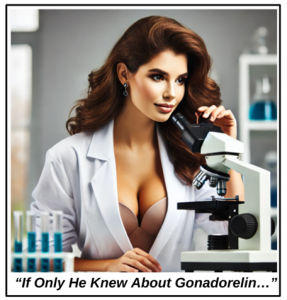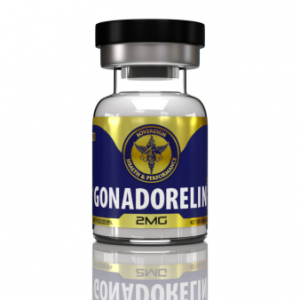Testosterone Replacement Therapy (TRT) and Shrinking Nuts
Introduction
Testosterone Replacement Therapy (TRT) is widely used to treat men with low testosterone levels, a condition known as hypogonadism. While TRT can significantly improve quality of life by restoring energy, mood, libido, and muscle mass, it comes with one notable side effect: the suppression of the body’s natural testosterone production. This suppression can lead to testicular atrophy, a condition where the testicles shrink in size due to decreased activity. This isn’t all that different from how your cardio fitness levels would plummet if you retired from IronMan competitions to focus exclusively on competitive eating.
Let’s take a look at the physiological impact of TRT, the psychological and social reactions to testicular atrophy, and a potential solution being researched (Gonadorelin).

Testosterone Replacement Therapy (TRT) is widely used to treat men with low testosterone levels, a condition known as hypogonadism. While TRT can significantly improve quality of life by restoring energy, mood, libido, and muscle mass, it comes with one notable side effect: the suppression of the body’s natural testosterone production. This suppression can lead to testicular atrophy, a condition where the testicles shrink in size due to decreased activity. This isn’t all that different from how your cardio fitness levels would plummet if you retired from IronMan competitions to focus exclusively on competitive eating.
Let’s take a look at the physiological impact of TRT, the psychological and social reactions to testicular atrophy, and a potential solution being researched (Gonadorelin).
Table of Contents
Endogenous Testosterone Suppression and Testicular Atrophy
When exogenous testosterone is introduced into the body through pellets, needles or magic, the hypothalamic-pituitary-gonadal (HPG) axis is disrupted. The hypothalamus and pituitary gland sense the increased levels of testosterone and subsequently reduce the secretion of gonadotropin-releasing hormone (GnRH) and luteinizing hormone (LH). LH is crucial for stimulating the Leydig cells in the testicles to produce testosterone. Without LH, the testicles take the hint they’re no longer needed, cease testosterone production, pack their bags and head off on an extended vacation leading to testicular atrophy.
Testicular atrophy can manifest as a noticeable reduction in testicle size. How much shrinkage are we talking about here? Will you need a microscope?? Several studies and clinical observations have noted the extent of testicular atrophy due to TRT:
- Research Study: A study published in the Journal of Clinical Endocrinology & Metabolism observed that men undergoing TRT experienced significant testicular shrinkage, with testicular volume decreasing by approximately 30-50% within the first few months of therapy.
- Clinical Observations: Clinicians often report that men on long-term TRT can experience a considerable reduction in testicular size. In some cases, the testicles can become as small as one-quarter of their original size. This shrinkage is a direct result of the suppression of the hypothalamic-pituitary-gonadal axis by exogenous testosterone

But wait, there’s more! Did you know testicular atrophy can affect semen production and volume? Indeed, we’re talking a decrease in the production of sperm and seminal fluid like there’s a kink in your garden hose. This reduction occurs because the testes are responsible for producing sperm and testosterone, both crucial for maintaining normal semen production and volume.
For some men, these changes have little to no impact on self-esteem or sense of masculinity. But let’s face it, others are horrified! Whatever the case, many men grit their teeth and prioritize the benefits of TRT over the distressing reduction in testicle size and all the baggage that comes with it. Additionally, partners may also have feelings about the physical changes, which can affect relationship dynamics. But does this even have to be an issue? What if a man could do TRT while maintaining testicle size and endogenous Testosterone? What does the research say?

Enter Gonadorelin: A Solution to Testicular Atrophy
Gonadorelin, also known as GnRH or gonadotropin-releasing hormone, offers a way to mitigate the side effects of TRT, particularly testicular atrophy. Discovered in the early 1970s, Gonadorelin is a synthetic decapeptide that mimics the natural GnRH produced by the hypothalamus. It stimulates the pituitary gland to release LH and follicle-stimulating hormone (FSH), which in turn promote testosterone production and spermatogenesis in the testicles.
By administering Gonadorelin in conjunction with TRT, it is possible to maintain endogenous testosterone production and preserve testicular size and function. This dual approach ensures that while the body receives the necessary testosterone supplementation, it continues to produce its own testosterone to some extent, preventing the testicles from becoming inactive, shrunken ghosts of their former selves.

Mechanism of Action and Benefits of Gonadorelin
Gonadorelin works by binding to GnRH receptors on the pituitary gland, stimulating release of LH and FSH. LH acts directly on the Leydig cells in the testicles to produce testosterone, while FSH is essential for the health and function of the Sertoli cells, which support sperm production. This stimulation maintains the physiological processes within the testicles, ensuring they remain active and functional.
The primary benefits for using Gonadorelin alongside TRT include:
- Prevention of Testicular Atrophy: By maintaining LH levels, Gonadorelin helps keep the testicles active, preventing shrinkage.
- Sperm Viability: Continuous stimulation of the Sertoli cells helps maintain spermatogenesis, crucial for men who wish to preserve their fertility.
- Psychological and Aesthetic Benefits: Preserving testicular size can help alleviate concerns related to masculinity and body image, improving overall mental well-being.
Featured Research Peptide
-
 Gonadorelin (GnRH)$39.00 – $82.00
Gonadorelin (GnRH)$39.00 – $82.00
Conclusion
Testosterone Replacement Therapy offers significant benefits for men with low testosterone levels, but it also comes with the drawback of suppressing the body’s natural testosterone production, leading to testicular atrophy. While some men and their partners may be unconcerned with this side effect, others may find it distressing. Gonadorelin provides a solution by maintaining endogenous testosterone production and preventing testicular atrophy. Understanding the mechanisms and benefits of Gonadorelin can help men make informed decisions about their TRT regimen and address concerns related to testicular health and masculinity.
References
- Testosterone Replacement Therapy and Suppression of Endogenous Testosterone Production:
- Snyder, P. J., & Lawrence, D. A. (1999). Treatment of male hypogonadism with testosterone. Journal of Clinical Endocrinology & Metabolism, 84(10), 3459-3462.
- Bhasin, S., et al. (2010). Testosterone therapy in men with androgen deficiency syndromes: an Endocrine Society clinical practice guideline. Journal of Clinical Endocrinology & Metabolism, 95(6), 2536-2559.
- Mechanisms of Testicular Atrophy:
- Urban, R. J. (2011). Hypogonadism in men with chronic systemic illnesses. Journal of Clinical Endocrinology & Metabolism, 96(1), 1-10.
- Schulster, M., Bernie, A. M., & Ramasamy, R. (2016). The role of estradiol in male reproductive function. Asian Journal of Andrology, 18(3), 435-440.
- Psychological and Social Reactions to Testicular Atrophy:
- Zitzmann, M., et al. (2013). Psychological correlates of testosterone levels in aging men. Aging Male, 16(1), 17-22.
- Gooren, L. J., & Saad, F. (2006). Recent insights into androgen action, benefits and risks. Maturitas, 51(1), 38-44.
- Gonadorelin and its Effects:
- Conn, P. M., & Crowley, W. F. (1991). Gonadotropin-releasing hormone and its analogs. Annual Review of Medicine, 42(1), 343-360.
- Thorner, M. O., et al. (1980). Continuous subcutaneous administration of gonadotropin-releasing hormone in hypothalamic amenorrhea: Effects on gonadotropin release and ovarian function. Journal of Clinical Endocrinology & Metabolism, 50(3), 526-531.
- Mechanism of Action of Gonadorelin:
- Delemarre-van de Waal, H. A., & van den Berg, H. (1992). Gonadotropin-releasing hormone and its analogs: Mechanism of action. Current Opinion in Obstetrics and Gynecology, 4(6), 819-823.
- Abou-Samra, A. B., & Jabbour, H. N. (2005). The GnRH receptor: structure and function. Human Reproduction Update, 11(3), 229-235.
- Benefits of Gonadorelin in TRT:
- Veldhuis, J. D., et al. (2005). Combined administration of testosterone and gonadotropin-releasing hormone maintains gonadotropin secretion and testicular size in hypogonadal men. Journal of Clinical Endocrinology & Metabolism, 90(7), 3928-3934.
- Matsumoto, A. M. (1995). Hormonal therapy of male hypogonadism: using GnRH and gonadotropins. Endocrine Reviews, 16(3), 306-328.
By referring to these studies and reviews, readers can gain a deeper understanding of the scientific basis behind the use of TRT, the associated side effects, and the potential benefits of incorporating Gonadorelin into the treatment regimen.

